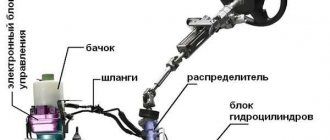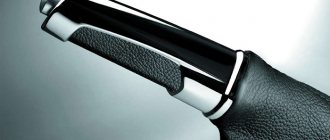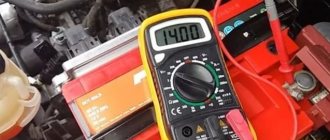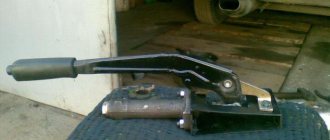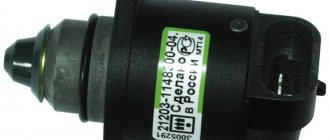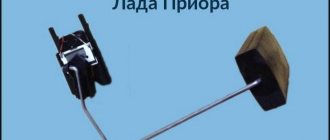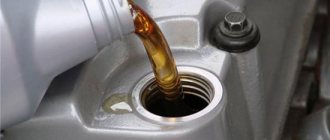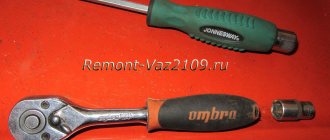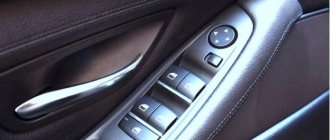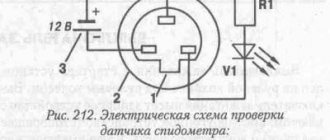Sometimes problems arise with hydraulic jacks. Most people throw them away immediately. But don’t throw it away, maybe the problem isn’t that big.
But it happens that the jack does not raise it to the required height. Previously, for example, the length of the rod was enough to lift the car, but now it is not. It rises halfway and that’s it. Oil is to blame here. More precisely, its lack.
When a working jack works, oil is still consumed. Quite a bit, but it is used up with each rise/fall. For good reason, it should be changed from time to time - about once a year. But who does this kind of nonsense here?) Usually it works as long as it works)
In general, two of my jacks malfunctioned. One is rolling, the other is bottle-type, both are hydraulic, of course. A rolling jack is the same as a bottle jack, only installed in a special design. After I raised the car, they slowly lowered it. I decided to add oil.
In general, it is recommended to add special hydraulic oils to such jacks. You can go and buy it, you can fill it with spindle oil, which is also hydraulic. Or you can, at your own peril and risk, top up with regular engine fuel. Which is what I did. This, of course, is not recommended, the properties of the oil are not the same, but oh well
.
First you need to lower the jack completely. We unscrew the fitting, lower the rod (or the lifting part of the rolling part), and screw the fitting back. We find the hole through which the oil is poured. It is closed with a rubber plug.
Reading time: 5 minutes
There are many types of lifting mechanisms, the most common among car enthusiasts is the hydraulic type of jacks (bottle, rolling). If improperly maintained, jacks can fail, for example, they stop lifting loads. And the question immediately arises of what to do if the hydraulic jack does not lift. You don’t have to buy a new one right away; there is always a way out; often everything can be fixed by performing maintenance on the unit.
Briefly about the main faults
- Stop. Occurs due to the lack of liquid in the chamber or the presence of contaminants in the oil.
- Insufficient lift height. Occurs due to a limited amount of working fluid.
- Slow rise, jerks. Explained by the presence of air, as well as a possible leak in the hydraulic system.
- Reduced pressure. The valve needs to be diagnosed or replaced. In this case, the jack also stops holding, lifting completely, springing, and can lower the load on its own.
Most often on forums you can find complaints that the hydraulic jack does not lift.
Do-it-yourself hydraulic jack repair, selection of spare parts
When repairing a hydraulic jack with your own hands, you must take into account that all the component elements of the device are fastened with threaded connections. Therefore, before starting repairs, the device must be disassembled.
WATCH THE VIDEO
The hydraulic bottle jack repair kit includes wrenches and an adjustable wrench. Then you should follow this sequence of actions:
- Drain the oil into a prepared container.
- Remove the piston and valve and inspect them carefully. If necessary, both elements are cleaned of rust accumulated on them.
- Google+
- LJ
- Blogger
- Check the support rod for bending. The most common malfunction is that the hydraulic jack does not lift the load. In this case, the support rod may be deformed and require replacement.
- In addition, it is necessary to pay attention to the condition of the gaskets. If one of the structural elements is deformed, then the hydraulic jack can be repaired by replacing the broken part. Even if the gaskets seem intact on the outside, it is recommended to replace them - often the damage is not visible to the eye.
- If oil is leaking, then most likely the oil valve needs to be cleaned of dirt. After all, because of its appearance, the ball does not sit well in its nest.
Do-it-yourself repair of a hydraulic rolling jack ends with washing all parts with a special liquid. Then you should assemble them in reverse order. Until the device is disassembled, it will not be clear what exactly led to its failure. Therefore, in principle, all types of faults are corrected using the same algorithm, but in different cases it is necessary to replace different parts.
When selecting spare parts, it is necessary to take into account that they must fully correspond to the deformed parts.
- Google+
- LJ
- Blogger
Design and principle of operation
The design of hydraulic jacks is approximately similar to both rolling and bottle jacks. Main parts of rolling devices:
- piston;
- lever arm;
- stock;
- suction valve;
- stop valve;
- oil reservoir;
- working cavity.
When the handle is lifted up, the shut-off valve is activated, and oil enters the chamber due to the operation of the suction valve. By pumping oil from the reservoir into the cavity of the working cylinder, the piston is raised. Next, to lower the piston with the rod, the bypass valve opens, then under the pressure of the load the piston will lower.
Hydraulic jack device (rolling and bottle)
The most popular types of hydraulic lift are rolling and bottle. Such devices have their own design features. Thus, the device of a hydraulic bottle jack includes a handle, a pump, a cylinder, a reservoir, a rod, a valve and a screw.
WATCH THE VIDEO
The diagram of a bottle hydraulic jack is as follows:
- The suction valve is located on the tank connection. Due to this, when lifting the jack, hydraulic fluid does not leave the cylinder.
- The valve is opened using a special screw. Thanks to this, the pressure level in the device decreases, and the lifted load falls to the ground.
The cylindrical liquid is especially important, since it is thanks to it that the load can be smoothly raised/lowered, as well as held at a certain height. It contains spindle oil, water and alcohol.
The principle of operation of a hydraulic jack is that the car is lifted by a horizontal rod resting against a special vertical mechanism. A lifting platform is attached to it, which is responsible for lifting the equipment. To lower the raised device, a special valve opens, after which air is pumped out of the system. Due to the decrease in pressure, lowering occurs.
Why won't the jack go down or up?
Reasons why the jack refuses to work:
- Cylinder failure. The working plane does not support the load; as a result, liquid flows from the cavity into the space above the piston.
- Damage to the mirror. Hydraulics lose efficiency or simply fail, this occurs due to improper transportation, it can lead to oil leakage and air entering the chamber, in which case corrosion will certainly begin over time.
- Corrosion. Leads to rapid wear of the cuffs and seals, which may result in dirt getting into the liquid and clogging the channels and valves.
- Unit fall. The greater the height from which the jack falls, the more serious the deformation of parts and main components can be.
- Too much load. Causes the rod to bend. This leads to misalignment of the main components and oil leakage.
- Use of the device for purposes other than its intended purpose, as well as failure to change the oil in a timely manner.
Types of breakdowns and their causes (why the jack doesn’t hold)
Most often, a hydraulic jack fails if it is overloaded (lifting loads whose weight exceeds the maximum weight for the device), or malfunctions occur in the hydraulics.
The failure in the first case is due to the fact that the thrust rod is deformed. As a result, it bends and cannot pass through the coupling, which causes it to jam. To restore the functions of the device, it is necessary to replace the rod. The fact is that it is made of special steel, which cannot be leveled.
- Google+
- LJ
- Blogger
But hydraulics can fail for several reasons:
- Machine oil, used instead of working fluid, leaks when the lift is stored in the wrong position. As a result, the oil leaks out and is replaced by air. Therefore, the operation of the device gradually slows down or stops altogether.
- The inner surface of the hydraulic system is rusting. This leads to the free movement of the device being disrupted.
Such problems are usually not serious, so you can fix them yourself at home. However, repairing hydraulic jacks is sometimes impossible, so it is easier to purchase a new device.
Troubleshooting Methods
Oil leakage is the main problem, due to which the rolling jack does not lift completely (if the leak is small) or at all (if the leak is significant). Because of this, air enters the cavity, and then the hydraulic jack works with little force or refuses to work at all. Leaks in the hydraulic system can be prevented by routine maintenance and checking the oil level. If the level is low, you just need to add fluid to the normal level.
Due to lack of fluid, air leaks into the hydraulics. This problem is solved by bleeding: you need to unscrew the cap of the oil tank and the bypass valve, and then simply pump the system, that is, move the lever up and down until the liquid passes into the main cylinder.
Often the cause of hydraulic jack malfunction is corrosion on the pistons, rods and cavity of the unit. To determine the cause in detail and repair it, you will have to disassemble the device.
A bent rod is also a common reason why a rolling jack does not lift or operates jerkily. In this case, you can change this element by taking an analogue from the old model, or purchase a new part. In most cases, such a malfunction cannot be repaired at all, even in a workshop or service center. This is explained by the fact that the rod usually bends under shock loads, and in this case the main elements of the housing are damaged. In this option, it is cheaper to purchase a new unit without having to restore or replace individual parts.
When the bypass valve becomes deformed or dirt simply accumulates in it, the valve ball sits tightly in the seat and hydraulic fluid leaks through it. In this case, you will simply have to replace it and replace the old (contaminated) oil with new one.
Main malfunctions and their causes
Among all the reasons why a hydraulic rolling jack, bottle jack or diamond jack does not work, there are 3 main options: system clogging, valve failure or rod damage. It is on these 3 pillars that the most common breakdowns associated with a decrease in efficiency or complete failure of the system are based. For greater clarity, let's look at each case in more detail.
System clogged
may be caused by air, dust or dirt entering the liquid. As a result of the first option, the jack stop may not rise, spring strongly, or even fall completely under load. Accumulated lumps of dirt can limit the movement of the valves, which will no longer tightly close the channels, allowing fluid to pass in both directions. In this case, the stop will not be fixed in one position, gradually lowering to the zero point. When determining why a hydraulic jack does not hold, you should first pay attention to the cleanliness of the system.
Valve failure
, in addition to mud clogging, can be caused by mechanical damage. The ball at the end of the spring, resting in a cone-shaped groove, can become detached or get caught on other structural elements. In this case, the rod will not rise at all, since the circulation of liquid in the system is disrupted and pumping is not performed. This breakdown is more complex and requires disassembling the device. It is not recommended to consider it before checking the system for blockages.
Rod damage
may occur due to non-compliance with maintenance or storage conditions, as well as from working with large loads and violating operating rules. In the first case, the piston may become corroded, which will reduce the tightness of its seal to the cylinder, resulting in liquid leakage. If you lift loads that are heavier than the permissible limit, the stop may bend. The chances of such a breakdown increase with the maximum extension of the screw and uneven installation of the jack on the ground. Rod deformation is considered the most serious failure, which cannot always be repaired even in special centers.
Having covered the main causes of malfunctions, let’s move on to specifics. We will analyze the main problems and offer solutions.
Doesn't hold under load
The descent of the rod when resting on the load and even without strong pressure can be caused by two reasons: lack of oil or faulty valves. To find out for sure why a hydraulic rolling jack lowers, it is better to go from simple to complex. We will analyze each option separately, according to the degree of complexity of the repair procedure.
- The lack of oil is associated with banal leakage in the absence of sealing. It may be a consequence of long-term storage of the tool with the shut-off valve unscrewed or wear of the gaskets. The problem is solved by adding fluid and pumping the jack. It is better to use special hydraulic oil, but simple industrial oil will do just fine. If after filling the liquid leaks out, even with the valve tightly closed, it is worth purchasing a repair kit and replacing all the gaskets.
- Valve failure can be caused by system clogging or mechanical damage. If the rolling hydraulic jack does not hold, it is not necessary to disassemble it immediately. It would be more rational to first rinse the internal channels, which may be clogged with dirt. To do this, drain all the oil from the system and fill it with flushing liquid (you can use kerosene or gasoline). We pump several times, drain and repeat the procedure a couple more times using clean liquid.
Fault Detection
The rod extends to the desired height, but then slowly (without load) lowers - in this case, the reason is most likely in the bypass valve and damaged o-rings, so the required pressure is not maintained.
If the rolling jack does not lift to the end, it means that the working stroke has decreased. At this point, the culprit is the corrosion that has formed on the rod and the surface of the cylinder. If the load being lifted is greater than the lifting capacity of the jack (indicated in the passport and on the body in tons), then there is a possibility of damage to the rod and its bending.
In order for the jack to serve for a long time and not break, you must remember the following rules:
- Hydraulic fluid replacement is necessary 2 times a year.
- If the lifting device is used every day, the hydraulic fluid should be changed monthly.
- In extreme cases, any hydraulic fluid can be used, but in winter it is recommended to use synthetic oils specified by the device manufacturer.
- To prevent the oil from thickening in winter, it is necessary to store the jack in a dry, warm place.
- It is not recommended to use the jack in the cold in winter, because it may simply stop working.
To fix a breakdown, you can lose a lot of time and money, so it’s easier to follow the operating instructions for a hydraulic jack, and then it will last a long time and will help lift the load more than once.
How does a hydraulic jack work?
To accurately determine the cause of the breakdown and its subsequent elimination, you should have a clear understanding of the operating principle of the device. Fortunately, hydraulic jacks are quite simple, and most of their problems can be fixed on your own. Contacting service may be necessary in cases of serious defects or a complete lack of desire to read the repair instructions. The foundations for understanding the operation of the device should be laid by analyzing the main components of its mechanism.
Before describing the functional elements, it is worth noting that hydraulic jacks have several subtypes and are divided into rolling, bottle and diamond-shaped. The classic type of liquid lifting mechanism is most closely related to the bottle type, which includes devices with a telescopic, hollow, hook-on and standard rod. To form a correct basic idea, we will analyze the original model without additional modifications. So, a hydraulic bottle jack consists of the following components:
- Body base
. Support platform for installing the device on a flat surface. - Frame
. The outer part of the hydraulic jack and, in combination, the oil reservoir. - Plunger cylinder
. A sealed chamber where fluid pressure is created, pushing the rod out. - Working plunger
. A retractable element with a stop at the end. - Oil filling hole
. Located in the upper, side part of the device body. - Screw
. Retractable element to increase the lifting height of the jack. Screws into the plunger. - Housing head
. A threaded connection that fixes the position of the body in relation to the cylinder. - Sealing ring
. Provides sealing of the oil reservoir, preventing fluid leakage. - Screw nut
. The upper part of the housing head has six edges for easy unscrewing. - Earring
. A convenient element for manual transportation of the jack. Not available on all models. - Screw head
. The end part of the rod that rests on the load. - Lever arm
. A removable element of the hand pump that increases the impact force several times. In most cases, it includes a special groove for unscrewing the shut-off valve (more on that later). - Discharge plunger
. The main element of the pump, driven by a lever. Pumps liquid from one reservoir to another. - Pump cylinder
. Sealed chamber and intermediate link in pumping oil between tanks. - Stop valve
. Serves to integrate/isolate the oil reservoir with the plunger cylinder. - Suction valve
. Regulates the movement of fluid inside the device, allowing it to flow in only one direction (only towards suction into the pump cylinder). - Bypass valve
. The opposite of suction. Allows the pump plunger to squeeze oil out through itself, but does not let it back in.
Repair of rolling jack
Without a jack, a car enthusiast, without exaggeration, is left “without hands.” And it is needed not only to change a tire on the road. A good jack is indispensable for some types of repair work - especially in a regular garage that is not equipped with a lift. For example, when assembling the suspension after repair, when it is necessary to make the final tightening of the levers. There is absolutely no need to lower the car onto the wheels so that the silent blocks take the “working” position - just jack up the lever to give it the desired position. A rolling hydraulic jack is especially convenient - thanks to its design, it can be installed under a part located low - so that no other jack can get under it. But, like any other mechanism, the jack can fail. Repair of a rolling jack is available to anyone who repairs a car themselves. We’ll just tell you what you need to pay attention to first when repairing a rolling jack with your own hands. First of all, let's look at its device.
Jack operating diagram
Diagram of operation of a hydraulic jack
Professional rolling jacks differ in size and load capacity. As a rule, the valve is controlled by turning the handle, which is very convenient during operation. But the principle of operation of all hydraulic jacks is the same, so it is more convenient to use the diagram - after all, despite the size and type of products, they have the same causes of breakdowns.
Rolling jacks differ in size and load capacity. Typically, the valve is controlled by turning the handle.
The force created by the plunger is transmitted through the oil used as the working fluid to the piston connected to the rod. In this case, oil is pumped from the front cavity of the jack cylinder to the rear cavity (from the plunger side). The bypass channel is closed, and the inlet and discharge valves allow the oil to move only towards the rear cavity, that is, the jack works like a pump. When the bypass needle (which is a pointed threaded rod) is opened, oil can flow back into the front cavity through the bypass channel. If at this moment the jack is under load, the piston rod will sink into the cylinder. The performance of the jack is ensured by compliance with three conditions:
- Tight fit of valves to seats.
- Required oil level.
- No air bubbles in the oil.
The rolling jack does not “hold” - how to repair it
Do-it-yourself repair of a rolling hydraulic jack
This is usually due to either a lack of oil in the jack, or damage or contamination of the valves . In the first case, it is enough to add oil to the jack. What kind of oil should I put into a hydraulic rolling jack? There is absolutely no need to look for some special oil for this. Although, if you use the jack all year round, then it is better to fill it with synthetic motor oil - after all, it thickens less in the cold. In some car services, when the turnover gets stuck, they generally fill in the “working off”. But doing this is extremely undesirable - used oil is dirty and contains a large percentage of aggressive sulfur compounds.
How to bleed a hydraulic (bottle) jack since it has stopped lifting and is springing?
I have a hydraulic (bottle) jack from Kuvalda 5 tons, all the liquid was accidentally drained from it. Is the fluid suitable for power steering and should I bleed it at all? Maybe someone can tell me?
- Steering wheel vibration when braking! SOSSSSSSSSSSSSS
- selection of brake discs
- chassis Volkswagen Passat (B3/B4)
- When it's hot, it won't start until you press the gas to the floor, and then you have to turn it for a long time?
- Autotest
- Do you want clear headlight reflectors?
A spindle (spindle hydraulic AU) is poured into hydraulic jacks, so it prevents the formation of an emulsion, protects equipment from wear and corrosion, and has high performance properties.
Look at how a guy repairs a hydraulic jack, everything is very accessible and detailed. And that’s for sure about the spindle, power steering fluid is not suitable, IMHO.
Before pumping: 1. you need to check the valve; to do this, unscrew the valve and check for deformation or dirt getting inside the valve; if the valve is in a faulty state due to mechanical deformation, then it simply needs to be replaced; 2. you need to drain the oil completely; 3. all parts must be washed to remove dirt and oil; 4. Open the oil tank cap and the bypass valve, and then quickly pump the hydraulic press pump several times.
You need to pump it like this, there is a hole on the side of the jack, through it you fill in spindle oil or any hydraulic fluid (not important), then push the piston out all the way using the hydraulics, put the jack on its side with the filling hole up and press in the piston - this should force the air out of the hydraulic cylinder, then, if necessary, add oil and, if necessary, repeat the operation a couple of times.
The rolling jack does not lift
#1 Gromozeka
- VIP Member
- 911 messages
- Car make: Lada 2114
- From: Rostov-on-Don
#2 Samen
- Car make: VW Sharan
- From: Bryansk
Please tell me how to cure it. They gave me a cheap rolling jack. But he doesn’t want to lift the car. It lifts up to a certain point, and then the leg rises and falls to the previous level when pumping with a pump. I understand there is air in the system? Who dealt with this? The valve tightened well.
Probably this certain moment is the maximum height of rise. Or maybe you need to add oil to it.
#3 Gromozeka
- Car make: Lada 2114
- From: Rostov-on-Don
Probably this certain moment is the maximum height of rise. Or maybe you need to add oil to it.
He definitely didn't rise all the way. I tried it without a car and it rises normally to full height. But it doesn’t support the weight of the car.
#4 _Lelik_
- Car make: VAZ-21099
- From: Kaluga
View Garage
#5 Gromozeka
- Car make: Lada 2114
- From: Rostov-on-Don
This means we need to look at the system. Either add oil or check the cuffs and seals. If it is old, the rubber bands could very well become stiff and begin to poison.
he's new. Tell me how to service it?
#6 Radio technician
- Car make: VAZ 21053
- From: Ekaterinburg
Please tell me how to cure it. They gave me a cheap rolling jack. But he doesn’t want to lift the car. It lifts up to a certain point, and then the leg rises and falls to the previous level when pumping with a pump. I understand there is air in the system? Who dealt with this? The valve tightened well.
Keyword given . It’s a pity to throw it away; it’s nice for a person to make hotza. And no one bothered to scratch his turnip and use this tool.
#7 Samen
- Car make: VW Sharan
- From: Bryansk
He definitely didn't rise all the way. I tried it without a car and it rises normally to full height. But it doesn’t support the weight of the car.
Try adding oil.
#8 Gromozeka
- Car make: Lada 2114
- From: Rostov-on-Don
Try adding oil.
I see 2 valves. One is for air, and the second, as I understand it, is for adding oil?
#9 shmelevdenis
- Car make: vaz 2115
- From: tver
Please tell me how to cure it. They gave me a cheap rolling jack. But he doesn’t want to lift the car. It lifts up to a certain point, and then the leg rises and falls to the previous level when pumping with a pump. I understand there is air in the system? Who dealt with this? The valve tightened well.
in my opinion it needs to be bled as you are bleeding the brakes
#10 Went
- Car make: VAZ 21093
- From: Dimitrovgrad
View Garage
#11 RomzesXIII
- Car make: VAZ 2112
- From: shaRashka Podolsk MO
Here's from another forum that might help:
- Gromozeka likes this.
